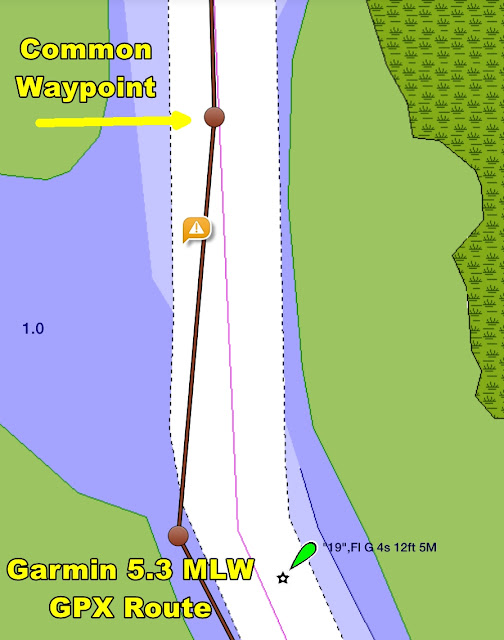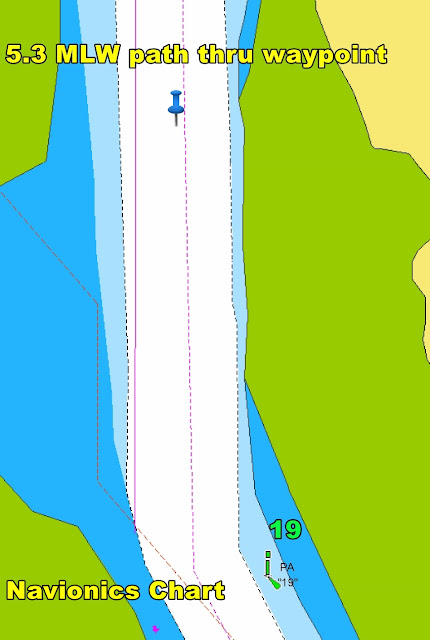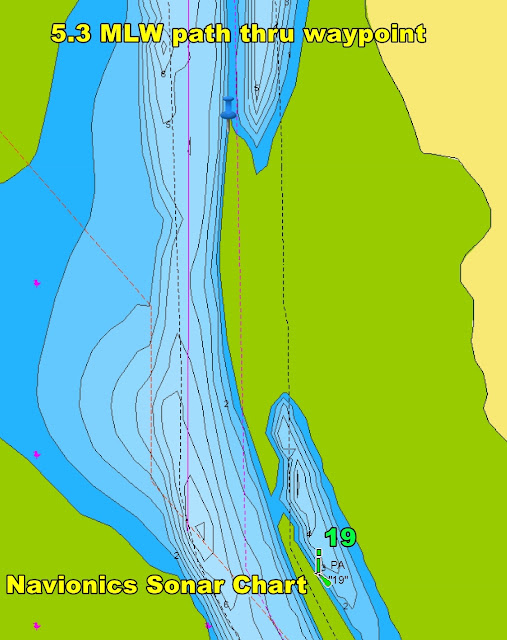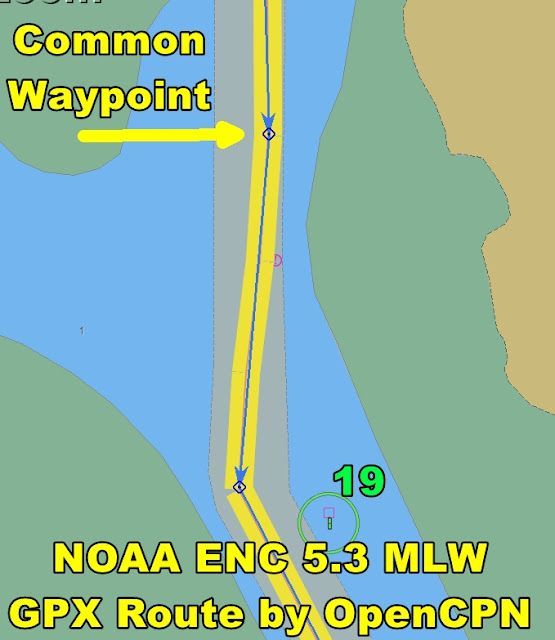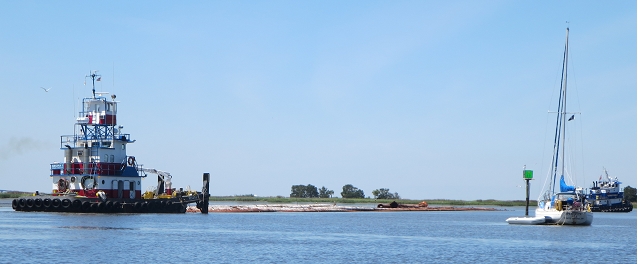Saturday, August 19, 2017
When I first started out in 1985, I assumed that everybody’s charts all agreed and any reference to the magenta line would be a good framework for passing information on the best path. Now I know that not to be true, an opinion forced on me by reality. However, I am still guilty at times of using the magenta line in referencing a path through a hazard. I’ve tried to avoid that in my latest postings but old habits die hard. In the future, I’ll double down on changing my posts to only reference routes relative to visual data (e.g., visual center of channel, relative to markers, etc.) I’ve taken to using Navimatics Charts and Tides which does not incorporate a magenta line. I have written permission from the owner of Navimatics to use his charts in my book so there are no magenta lines shown there except for a few examples of what not to do.
In one famous area, I plotted a route through Jekyll Island where I found 5.3 MLW (5.3 ft at 0.0 tide). I converted that path to a GPX route and imported the route into Navimatics Charts and Tides, The Garmin app, and NOAA ENC charts as displayed by OpenCPN on my PC. The results were enlightening. The route I took did not follow the same “channel” as shown in the three apps. Jekyll is an area of the ICW where there appears to be a shifting of the datum for the charts between vendors. All this brings into question advice like, “Favor the green side of the channel (or red side).”
The Navionics app does not allow for the importing of GPX routes much to my dismay. I called Navionics on this and they just said they had no plans to implement that feature. The app does allow communication of GPX waypoints from a partner chartplotter but not directly into the app via a GPX import function. It will let you create a route by tapping on the display but the waypoints so created don’t show up with Lat/Long coordinates. In order to get a common waypoint for comparison purposes, I took the shallowest part of the route (just north of G19) and manually added the shallowest waypoint in my trip through Jekyll Island on 4/20/2017. That took about 20 minutes for that one waypoint since the app does not allow you to edit the Lat/Long of the waypoint. You have to tap, look at the Lat/Long (at least they show that much!), erase the waypoint if not accurately placed for the shallow spot and then repeat the process until you get a waypoint Lat/Long that matches the shallowest waypoint of the route I took for 5.3 MLW. The waypoint then shows up on all the charts shown below.
Now for the charts:
The first one is the Navimatics Charts and Tides app showing the GPX route I entered for Jekyll Island based on my spring trip up the ICW where I found 5.3 MLW minimum. I’ll start with the Jekyll Island channel just north of G19. The “Common Waypoint” will appear on all the following charts so we can watch how different vendors display the same waypoint on their charts. You can see that the route is pretty much in the middle of the channel by G19 but diverges to the green side at the Common Waypoint. As an aside, one way ask, “How did you come up with this and how do you know it’s the best path?” Well, on the way north I was muddling at my usual slow pace in the shallow waters and I noticed the locals whizzing by me at high speed but quite a bit east of me, outside the charted channel. On the way south in the fall, I was more in the center and found the water shallowing to 3.0 MLW so I knew the answer was not to favor the red side. So I said “what the heck” and wandered over to the green side where I then discovered why all the locals were using that path, it was deeper (it’s also the outside of the curve). Perhaps it’s even deeper than 5.3 MLW farther over but I was happy at what I found so I didn’t go farther east. I also knew that you needed to standoff G19 by 80 ft or so. I had visited a sailboat that was hard aground that afternoon when he used G19 as a turning buoy, not good.
Next is the Navionics USA HD app. It costs $49.99 for a one-year subscription which has to be renewed annually. The yearly price seems to vary somewhat so you may find it different. There are numerous updates during your term that usually run 300 to 500 MB each if you do them monthly. For the chart below, I didn’t go to all the trouble of plotting every GPX waypoint since it was so time intensive. I just put the shallowest waypoint with the blue pin that the GPX route passes through. In the example below, the Navionics chart shows the shallowest spot right in the middle of the channel. That’s good. I didn’t plot what happens by G19, maybe next week. The dotted, red line by the blue pin is labeled, “Centerline of a recommended route”, not bad guidance. The solid, red line to the west of the blue pin has two labels, “Navigation line – leading line bearing a recommended track” and “Recommended Track.” I have no idea what they mean by that. Which one should you follow? In this case, it’s the dotted line but how would you know without more input?
Next up is the Navionics SonarChart. It takes input from boaters with Navionics compatible sonar units that upload readings through local WiFi in real-time (or later if WiFi is not available immediately). I have one of the compatible units, the portable SonarPhone T-Box for $199.95. You will notice right away that the blue pin (location of 5.3 MLW path) sits on top of what the chart shows as 0.0 MLW. If one follows the chart which shows the channel farther to the red side, shallow water will be found. In many places on the ICW, the SonarChart gives accurate information, just not always. They are dependent on receiving updates from those that have their sonar compatible units installed. Unfortunately, they also do not time stamp their sonar charts so you don’t know the age of the soundings.
However, just to confuse the issue more, the same two guidance lines shown on the Navionics chart above are also shown on the SonarChart. So if you’re passing by the area just north of G19 in Jekyll Island, which line do you follow? If a boater is following the SonarChart contours, it would take a brave boater to continue on the dotted, red line with the chart showing disaster ahead – but that would be the correct thing to do in this case, at least by the 5.3 MLW waypoint! I’m not speaking for the area of the chart (or dotted, red line) by G19, that’s a story for another day. I would have to manually put in a bunch of waypoints into Navionics to discover if their dotted, red line is good by G19.
Next up is the Navionics rendering of the NOAA ENC chart of the same area. The first thing you might notice is the absence of a magenta line. However, it compares closely to the Navimatics chart as it should since they are both based on the same NOAA ENC chart. The advice to favor the green side of the channel above G19 would still make sense. The turn by G19 also looks the same as expected.
Finally, we come to the OpenCPN display of the NOAA ENC chart. The GPX route is displayed and looks identical to the GPX route displayed by Navimatics. It’s a comforting thought that the various charting programs display the Jekyll GPX route the same as long as NOAA ENC charts are used. I would give up if even they were different.
So, what to make of all this? Both Garmin and Navionics must use the NOAA ENC charts as base charts but I have no idea why they should be different (except, of course, for the Navionics SonarCharts which are user modified). The Navionics app is certainly capable of displaying accurate charts per Lat/Long as demonstrated by their rendering of what they call the “Govt Chart.” I am now challenged on how to describe the 5.3 MLW path I found 4/20/2017. If I use favor green or red, the boater would have to have the same charts I do to find the same path. The charts even vary between different charts supplied by the same manufacturer (in the example above for Navionics Govt vs their native charts vs SonarChart).
So in the future, I’ll always reference the NOAA ENC chart but try to avoid all references to a magenta line and attempt to reference visual info like “visual center of the channel, more to one side or the other, 100 ft off a marker, etc. But that’s not good enough for some areas, especially Jekyll Island where the markers are far apart and the deep water is not obvious.
The other option is to publish GPX routes. Boaters could if they chose to load the route, follow the exact route I took for the water depths I found. That would get you along the same path with good accuracy but there’s a caveat even with that! Jekyll is known to be very sensitive to wind tides. If there’s a strong (>20 kts) wind out of the east for a few days, you’ll wonder what all the fuss was about. Such a wind will add at least 1 ft to all readings. On the other hand, if there’s a strong wind out of the west (up to 1 ft less water), you’ll be able to discover all the pleasures of a shallow water passage through Jekyll Creek.
Note: although the routes I publish are ones I have personally taken, except where noted for Army Corps of Engineers (ACOE) routes, Jekyll is my own experience, Do not speed through at 20 kts! Things change on the ICW. Barges may come through and plow up mud and change the channel, especially in Jekyll Creek. I’ve seen a pair of barges go through the creek at dead low tide with a 1000 ft of dredging pipes loaded. They plowed mud!! They are probably the only reason Jekyll doesn’t silt in all the way. Just look below, that’s the two barges going around G19 at dead low tide. It took about an hour to get all the way through with lots of mud flying behind the barges. Perhaps the sailboat had more water after that than he expected?
If you want to have the exact waypoints I used, download BJekyll. You can see all the GPX routes at GPX Routes on my blog site at fleetwing.blogspot.com. I also published the 2017 ICW Cruising Guide if you want similar information for other shallow areas. Ann and I will be leaving Poughkeepsie YC, New York, around September 15 for our eighth cruise from NY to Key West. Please join us for the trip south. I’ll be updating what I find in my blog.
Posted by Bob423 at 1:35 PM 5 comments
Sunday, August 13, 2017
Dawho River - Beware the Magenta Line
We all know that the magenta line does not always lead you to the deepest water, in fact, it often does not. It's a handy guide to finding the general direction but you often need more data. I compiled a series of charts by various navigation programs to compare the routes through one of the more challenging areas of the ICW, namely, the east entrance to the Dawho River south of Charleston.
Below is the chart as shown by Navimatics Charts and Tides with a route plotted that I followed for a minimum of 5.5 MLW on 4/25/2017.
The chart correctly shows deeper water 400 to 450 ft north of G115. The yellow line is the path I took on 4/25/2017. If you have the latest charts, you should see a similar path highlighted corresponding to the lighter shade of blue above.
Next up is the same area as shown by the Charleston ACOE survey of 11/17/2016.
Unfortunately, the original channel has shoaled down to 3 ft but it's deeper farther north. Also unfortunately, the Charleston ACOE does not survey outside the old channel so we are left to our own devices - trial and error. I hand-drew the blue line to show the same route shown in the Navimatics example at the top.
Let's take a look at the Garmin chart of the same area.
In this case, the brown line is the exact path I took on 4/25/2017 for 5.5 MLW. I converted it into a GPX route which can be download at BDawho. Notice where the magenta line goes, it's much too far south. Compare that excursion south against the ACOE survey chart, it's shallow!
Next up is the Navionics chart for Dawho.
It shows a better depth using the more northerly route but the magenta line is still too far south.
Finally, let's take a look at the Navionics Sonar chart of the same area.
This is not bad although it shows less depth than what I experienced following the blue route. The Sonar chart by Navionics looks good for this passage but you never know the time stamp on the soundings and which areas are based on actual soundings and which areas are interpolations (or whatever). It would be nice if the Sonar chart showed where real data was used and given a time stamp.
So what to do? Active Captain is a source of current data along with alerts from Cruisernet and similar services. To get everything in one place, the 2017 ICW Cruising Guide is another option, which also comes in ebook format (free, with the hardcopy version). As I head south, I'll be updating Active Captain posts under the handle Bob423 and adjusting the GPX routes as needed. After all, the whole point of cruising down the ICW is to enjoy the ride. There are lots of sunsets to see, friends to meet, and quiet times just enjoying the trip.
Posted by Bob423 at 12:36 PM 0 comments
Friday, August 4, 2017
2017 ICW Cruising Guide Now Available
I published the 2017 ICW Cruising Guide this morning. It is immediately available by clicking on the link at left that shows the book's cover. This year's version is formatted 8.5 x 11 inches and 220 pages long with all pictures and charts in full color. It's a direct order from the publisher, CreateSpace. The same book from CreateSpace will be on Amazon.com in a few days along with the ebook version. For a description of the guide, please see the previous post.
If you purchase the hardcopy version at left, then the ebook is free. Just send me your email address after purchasing your copy and I'll forward a link to download the ebook. To clarify, A free ebook is available to those who have purchased the hard copy book. If you bought the book off Amazon.com, the ebook is automatically approved for free when you place the ebook order. If you bought it directly from CreateSpace (the link on the blog), then just send me your email address and I'll give you a link for downloading the ebook. My email address is: 423sail@gmail.com
In a few days I'll post an article under "ICW Tips" with all the hyperlinks that are underlined in blue in the book so you don't have to Google anything. Of course, the ebook has all the links already active so that's another way of accessing the references in the book. For the first time, the ebook also has an active Table of Contents in Kindle format for easy access.
This book has been a labor of love. I give thanks to my sister who is an English major for all the corrections in grammar and spelling although any remaining errors are all my own. I even found myself making errors in trying to correct errors! The formatting of ebooks is a nightmare. You just cannot get all the pictures and text to correctly flow like you can in a hardcopy book. I did the best I could after six revisions. Everything is there in the ebook, it just tends to be scattered somewhat due to the reader's choice of type size and device.
Please leave comments and/or a review on Amazon.com. The reviews help everybody.
Now I'm off to Ocean City, NJ, for a week at the beach with the Fleetwing crew (no, I'm not taking the boat - as someone always asks).
Posted by Bob423 at 9:27 AM 2 comments
Subscribe to:
Posts (Atom)




